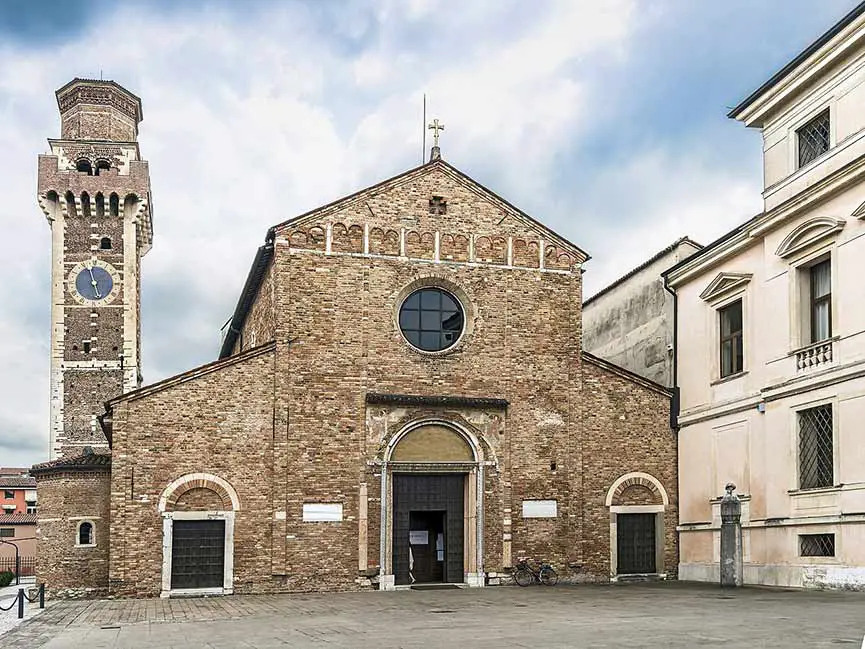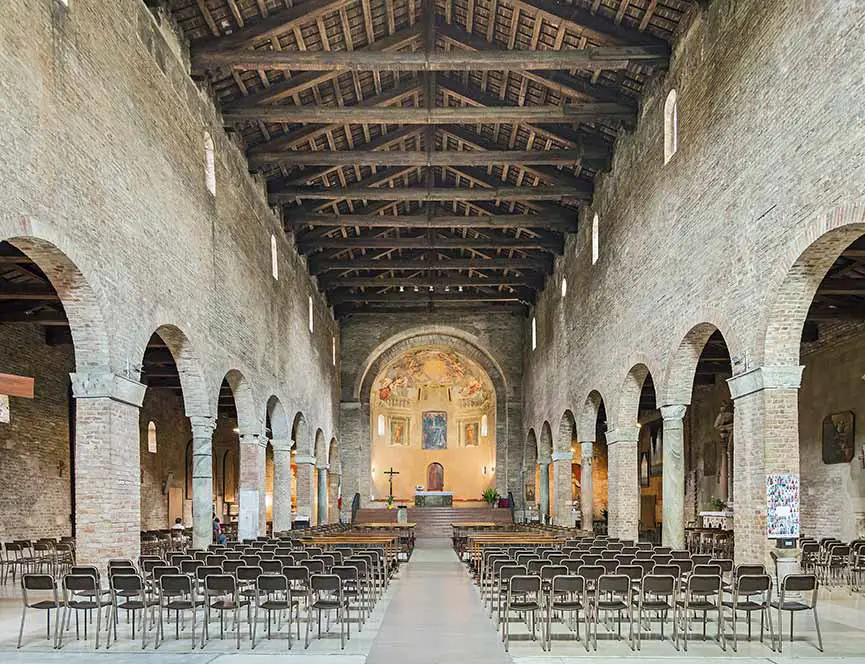 Basilica of Santi Felice e Fortunato - Corso Ss. Felice e Fortunato, 219
- Vicenza Basilica of Santi Felice e Fortunato - Corso Ss. Felice e Fortunato, 219
- Vicenza
(Foto: Basilica dei Santi Felice e Fortunato (Vicenza) - Facade, CC BY-SA 4.0, via Wikimedia Commons)
Basilica of Santi Felice e Fortunato in Vicenza
The Basilica of Saints Felice and Fortunato is located in Corso dei S.S. Felice e Fortunato, not far from the railway station and about 1 km west of the center of Vicenza. The building is named after the Vicenza martyrs Felice and Fortunato killed in Aquileia during the persecutions of Diocletian at the beginning of the 4th century.
The first cult building was built in this place following the edict of Constantine (313) on an area already affected by burial activity; but with the arrival of the remains of Felice da Aquileia towards the end of the 4th century it was decided to build a basilica with three naves measuring 45 x 22 metres. The church was built inspired by the basilicas of the city of Milan. In 899 it was almost totally destroyed by the Hungarians who invaded Italy.
Rebuilt in the 10th century and entrusted to the Benedictine monks, the Basilica was later damaged by the Verona earthquake of 3 January 1117; the reconstruction led to the current appearance of the Basilica.
Among the works preserved inside the Stele of the Magi (5th century) and early Christian mosaics of the Martyrion (5th century).
Architecture of the Basilica of Saints Felix and Fortunato in Vicenza
 Interior of the Basilica
of Santi Felice e Fortunato - Piazza Duomo - Vicenza Interior of the Basilica
of Santi Felice e Fortunato - Piazza Duomo - Vicenza
(Foto: Basilica dei Santi Felice e Fortunato (Vicenza) - Facade, CC BY-SA 4.0, via Wikimedia Commons)
The external appearance of the building is due to the reconstruction in Romanesque style in the second half of the 10th century following the destruction of the previous Christian temple (5th century) by the Hungarians (899).
The facade is in brick and has a salient roof which suggests the tripartite division of the internal space. Also tripartite by narrow and slender pilasters, the façade has a portal with a round arch in each sector, but only the left remains original. The larger central portal is flanked by twisted columns and has a red and white marble frame and an architrave bearing the date 1154 and the name of the builder: Pietro Veneto. The central sector is also tripartite by even slimmer pilasters which allow the division of a space above the architrave into which the oculus is inserted with a deep splay.
Below the lunette there is a frame with Byzantine-style engravings and above - in the space below the architrave - traces of a fresco on the theme of the Resurrection of the dead (first half of the 11th century) while on the sides of the portal two plaques in Latin recall the interventions from 1425 and "in meliorem formam" from 1674. There is also a medieval epigraph with an inscription in Old French (13th century) on the left side of the facade.
The tympanum is embellished with stone columns, resting on pilasters, with pairs of arches above which together form a frame divided into eight sectors.
The exterior is completed by the presence of the beautiful bell tower and the Martyrion, a chapel built in the 4th century to house the relics of the saints to whom the basilica is named.
The interior - with three naves divided by two series of marble columns forming nine arches - is almost bare and has a wooden trussed ceiling.
The floor preserves a large portion of mosaic carpet dating back to the mid-fourth century and belonging to the first cult building. On some panels you can read the inscriptions with the names of the Roman patrons (Leontius et Mariniana, Carpi et Penetia, Splendonius et Justina, Felix cum Toribius et Immola).
History of the Basilica of Santi Felice e Fortunato
The first building of worship was built in this place following the edict of Constantine (313) which sanctioned definitive Christian freedom of worship and the official adherence to Christianity of the Roman Empire. The area was already affected by burial activity in the previous era; in fact numerous tombs have returned stems and inscriptions, coins and objects of various kinds. A band of red marble inside the current church defines what remains of the ancient early Christian place of worship. A large portion of mosaic carpet dating back to the mid-fourth century is preserved from this temple.
But with the arrival of the remains of Felice from Aquileia towards the end of the fourth century, the church experienced an unexpected popularity which made it unsuitable for welcoming such a multitude of faithful; therefore it was decided to build a basilica with three naves measuring 45 x 22 meters. To this was added a narthex and a quadriporticus of almost equal dimensions intended to accommodate the many visiting pilgrims.
The church, in its current proportions, was therefore built starting from the 5th century, inspired by the basilicas of the city of Milan and did not undergo any particular interventions throughout the High Middle Ages until 899, the year of its almost total destruction by the Hungarians who invaded Italy.
Rebuilt in the 10th century and entrusted to the Benedictine monks, the Basilica of Saints Felice and Fortunato was then again seriously damaged by the Verona earthquake of 3 January 1117; the reconstruction was immediate and on occasion the semicircular crypt was added. It is to this reconstruction that we owe the current appearance of the Basilica.
In fact, nothing remains of the fourteenth-century buildings - including a cloister - and of the later ones alterations following the Counter-Reformation which dictated, in addition to religious canons and dogmas, also corresponding architectural languages. The successive Baroque additions remained until recent times when they were eliminated, restoring to the basilica its harmony and sober elegance, typical of the Romanesque style that the building had achieved with the rebuilding after the earthquake in Verona.
Works kept in the Basilica of Saints Felice and Fortunato
– Stele of the Magi (5th century)
– Early Christian mosaics of the Martyrion (5th century)
Curiosity of the Basilica of Santi Felice e Fortunato
Internally, a strip of red marble can be seen on the floor: it marks the perimeter of the first church which had a single nave measuring 24 x 16.5 metres.
Information for the visit of the Basilica of Santi Felice e Fortunato
Style: Paleo Romanesque, Romanesque.
Construction: IV-X century.
Hours: Monday to Saturday from 9.00 to 12.00 and from 15.30 to 18.30.
Tickets: free admission.
Telephone: +39.0444.547246
Email: not available.
Website: not available. |